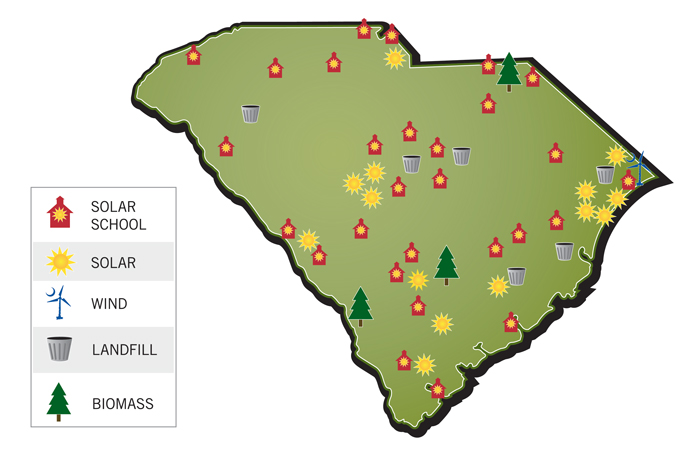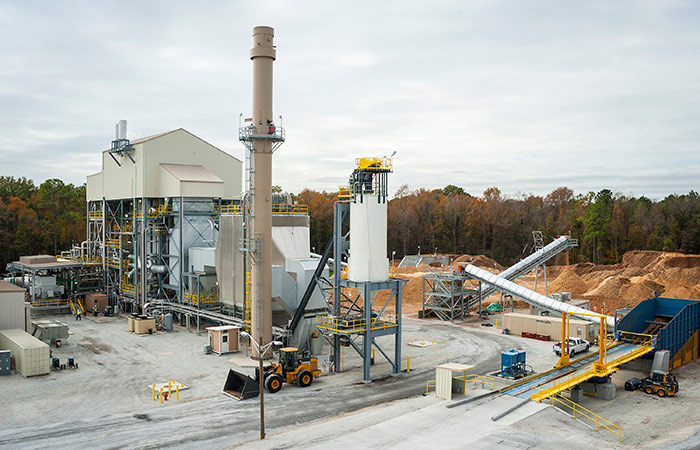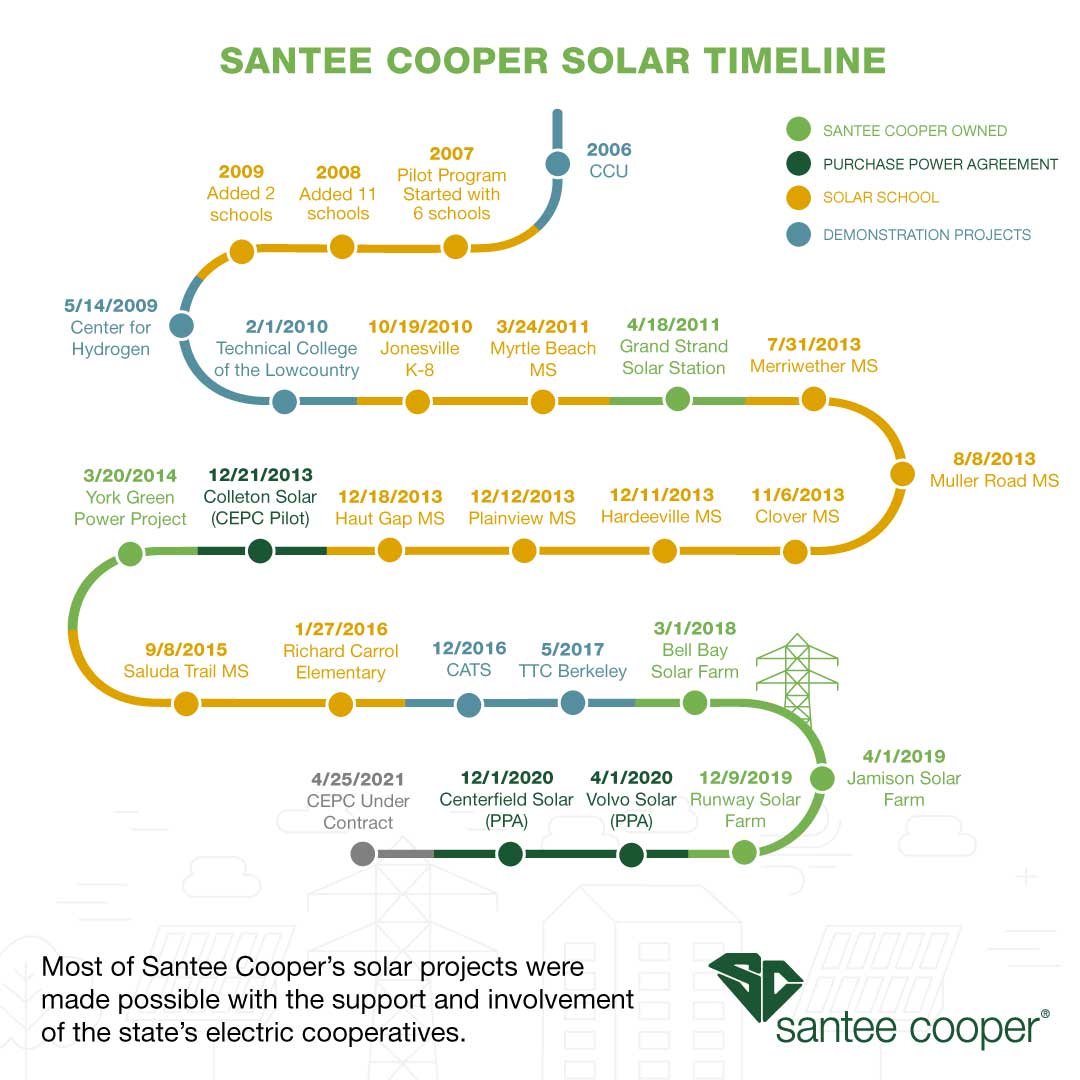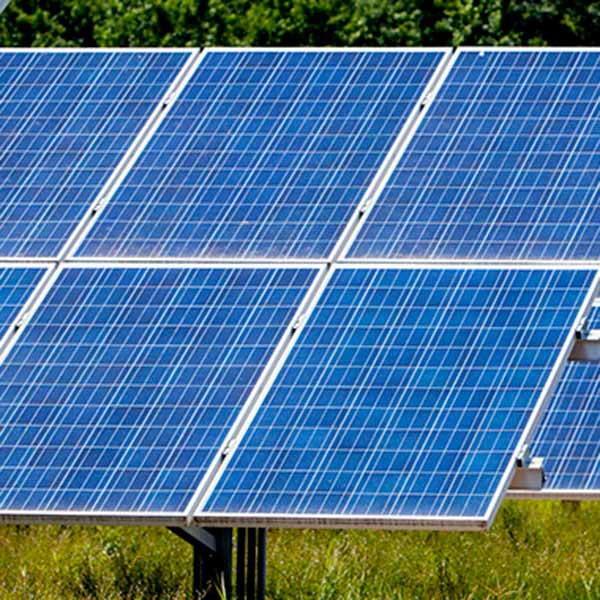Renewable Energy
In 2001, Santee Cooper became the first utility in South Carolina to offer renewable power to customers, with the launch of our Green Power program. Today, we have more than 800 MW online or under contract (not counting hydroelectric power).
We have successfully done this through utilizing renewable resources that are cost-efficient and through partnering with others to make renewables more affordable.
Renewable generation is part of our long-term commitment to environmental stewardship — to meet more of our customers' needs with renewable energy, energy efficiency and electricity that does not emit greenhouse gases.

Our renewable portfolio stretches across the state. Some of our renewable generation – certain landfill biogas, solar and wind power – is certified Green Power through Green-e Energy®, which means it meets strict and specific consumer standards. We purchase our woody and agricultural biomass power from independent power producers in South Carolina that utilize sustainable procedures.
Santee Cooper Renewable Energy is made in South Carolina from South Carolina resources, and it's helping power our state forward.

Biomass
Biomass is a broad category of renewable energy sources that are generated from organic matter. Common forms of biomass include forest and other wood waste, yard waste and animal waste. Santee Cooper has several contracts with independent power producers to generate biomass from wood waste and landfill gas.
As landfill waste decomposes, it produces methane gas, which can be converted into energy through a process that also reduces greenhouse-gas emissions. Santee Cooper is the only energy provider in South Carolina converting landfill methane gas into clean, homegrown electricity at six Green Power Generating Stations with a combined capacity of 28 MW.
As the name implies, woody biomass uses woody material from trees or shrubs to produce electricity. It's most often transformed to renewable energy through direct combustion, either alone or co-fired with coal. Woody biomass is often regarded as carbon neutral, so it produces fewer net greenhouse gas emissions than traditional fossil fuels. Typically, woody biomass materials are the byproducts of various forestry operations (e.g. harvesting and thinning). Through purchase-power contracts, Santee Cooper has 74 MW of woody biomass capacity.
Solar Power
Santee Cooper introduced solar to the South Carolina grid in 2006, installing a 16-kW demonstration project at Coastal Carolina University in Conway. In 2008, we piloted the state’s first utility rooftop solar program with customers. We opened the first utility-scale solar installation, the Grand Strand Solar Station, in 2011. Today more than 638 MWs of solar power is online or under contract by Santee Cooper and our largest customer, Central Electric Power Cooperative, for our combined system.
Santee Cooper receives additional solar power from installations in Chesterfield, Myrtle Beach, Bucksville, Orangeburg, Colleton, Aiken and Bluffton. We also have more than two dozen Green Power Solar Schools across the state, a project with the electric cooperatives of South Carolina to install 2-kW solar arrays and provide schools a renewable energy curriculum to help students learn about renewable energy and track output from their own solar panels.
Through Solar Share — the state's first community solar program — customers can subscribe to portions of the Colleton Solar Farm's output and receive rebates and monthly energy credits. Our Solar Home and Solar Business programs offer rebates and resources to help customers add rooftop solar systems to their home or business.

| School | Served by |
|---|---|
| Aynor Middle | Horry Electric Cooperative |
| Bennettsville Middle | Marlboro Electric Cooperative |
| Carver-Edisto Middle | Edisto Electric Cooperative |
| Carver Bay Middle | Santee Electric Cooperative |
| Chapin Middle | Mid-Carolina Cooperative |
| Chesterfield-Ruby Middle | Lynches River Electric Cooperative |
| Clover Middle | York Cooperative |
| Diamond Hill Middle | Little River Electric Cooperative |
| Hardeeville-Ridgeland Middle | Palmetto Cooperative |
| Haut Gap Middle | Berkeley Electric Cooperative |
| Hillcrest Middle | Black River Electric Cooperative |
| Hilton Head Middle | Palmetto Electric Cooperative |
| Hopkins Middle | Tri-County Electric Cooperative |
| Jonesville Elementary Middle | Broad River Electric Cooperative |
| Leslie M. Stover Middle | Fairfield Electric Cooperative |
| Mauldin Middle | Laurens Electric Cooperative |
| Merriwether Middle | Aiken Electric Cooperative |
| Muller Road Middle | Fairfield Cooperative |
| Myrtle Beach Middle | Santee Cooper |
| New Ellenton Middle | Aiken Electric Cooperative |
| Plainview Elementary | Pee Dee Cooperative |
| Richard Carroll Elementary | City of Bamberg |
| Ruffin Middle | Coastal Electric Cooperative |
| Saluda Trail Middle | City of Rock Hill Utilities |
| Sangaree Middle | Berkeley Electric Cooperative |
| Savannah Grove Middle | Pee Dee Electric Cooperative |
| Springfield Middle | York Electric Cooperative |
| Tamassee-Salem Middle | Blue Ridge Electric Cooperative |
Wind Power
Santee Cooper began studying the feasibility of wind energy in 2005 and has since worked alongside other partners in a series of research initiatives. Research shows that the best potential for generating power from wind in South Carolina lies offshore, although best estimates indicate the cost for offshore wind generation is about twice the cost of traditional generation.
We are also exploring applications for smaller wind turbines on shore, and we made South Carolina history in November 2010 as the first utility to install a wind turbine and connect it to the grid. The 2.4-kW system is located oceanfront in North Myrtle Beach.
